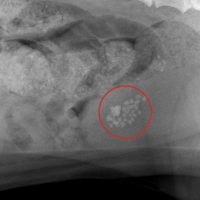What is Addison’s disease?
Addison’s disease is the common name for hypoadrenocorticism, caused by decreased hormone production from the outer part or cortex of the adrenal gland.
What are the adrenal glands and what do they do?
The adrenal glands are small, paired glands located near the kidneys. Each gland consists of an outer cortex and an inner medulla. The glands produce two important hormones that regulate a variety of body functions and are necessary to sustain life. The two hormones are cortisol, a stress hormone, and aldosterone, a hormone that regulates the body’s levels of the minerals sodium and potassium. Sodium and potassium levels are important for maintaining the body’s fluid balance.
What causes Addison’s disease?
Addison’s disease in dogs is primarily caused by an immune–mediated destruction of adrenal tissue. Less commonly, the adrenal glands may be damaged by trauma, infection, or cancer. Addison’s disease can also occur following treatment of Cushing’s disease (hyperadrenocorticism), in which too much cortisol and aldosterone are produced. If the medication used to treat Cushing’s disease inadvertently suppresses too much adrenal gland activity or damages the gland, deficiency of cortisol and aldosterone may result.
A secondary form of Addison’s disease can result from a tumor or defect in the pituitary gland, which is an important hormonal regulator located in the brain. Secondary Addison’s disease can also develop if a dog has been treated with long-term steroids for any reason and the medication is abruptly stopped. This last condition is known as iatrogenic hypoadrenocorticism and is generally temporary.
Certain breeds seem to be at increased risk for developing Addison’s disease. These include, but are not limited to: Portuguese Water Dogs, Bearded Collies, Standard Poodles, Nova Scotia Duck Tolling Retrievers, Leonbergers, Great Danes, and Labrador Retrievers.
What are the clinical signs of hypoadrenocorticism?
Clinical signs of Addison’s disease are usually vague and non-specific, meaning there are no particular signs that indicate a diagnosis of the disease. Addisonian patients may present with lethargy, diarrhea, vomiting, increased thirst, increased urination, and unplanned weight loss. Intermittent shaking episodes are sometimes seen. The signs may wax and wane.
Non-specific medical treatment like the administration of fluids or corticosteroids appears to help temporarily, but the signs soon return. If a pet experiences recurrent bouts of sudden lethargy, diarrhea and vomiting, increased thirst and urination, or other non-specific illness, Addison’s disease should be considered as an underlying cause.
What is an Addisonian crisis?
Sometimes this condition takes on a much more serious presentation resulting in sudden weakness, with severe vomiting and diarrhea, and sometimes collapse. This is an Addisonian crisis and is considered a medical emergency. Immediate hospitalization and supportive treatment are needed.
How is Addison’s disease diagnosed?
Diagnosis is based on your pet’s medical history, including any medications, clinical signs, and the results of common blood and urine tests, most notably electrolyte imbalances. The most definitive diagnostic test for Addison’s disease is the ACTH-stimulation test. In this test, cortisol levels are measured before and after injection of a synthetic form of ACTH. Additional tests such as basal cortisol levels, natural plasma ACTH, electrocardiogram (ECG), radiographs (X-rays), or abdominal ultrasound may be performed to rule out another cause for your pet’s clinical signs. In rare instances, MRI or CT may be needed to diagnose a pituitary gland problem.

How is Addison’s disease treated?
Once diagnosed, most dogs with Addison’s disease can be successfully treated.
Desoxycorticosterone pivalate; also known as DOCP (brand names: Percorten®-V or Zycortal®), is an injectable medication approved by the FDA for treatment of Addison’s disease in dogs. It is injected every 3–4 weeks, depending on the patient, and replaces the missing mineralocorticoid aldosterone. It is often supplemented by an oral glucocorticoid.
DOCP is not for every dog, and some Addison’s patients do best on oral medications that replace both the mineralocorticoid and the glucocorticoid such as fludrocortisone (brand name Florinef®).
Your dog’s diet and activity levels can often remain unchanged. The majority of dogs resume normal lives, even after an Addisonian crisis. Your veterinarian will discuss Addison’s treatment options with you and decide which therapy is best for your dog.
What is the prognosis for a dog diagnosed with Addison’s disease?
The vast majority of patients with Addison’s disease have a good to excellent prognosis once the diagnosis is made and they have been stabilized with the appropriate medications. Your veterinarian will provide you with information on the long-term prognosis for your pet.
© Copyright 2021 LifeLearn Inc. Used and/or modified with permission under license.






